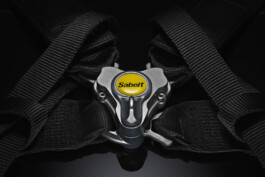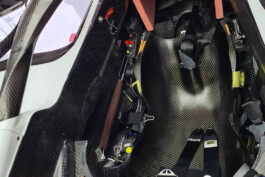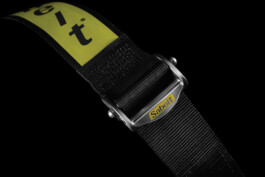



NEWS
FIND OUT MORE ABOUT SABELT WORLD!
01 DECEMBER 2020






SABELT SEAT BELTS IN THE ACCIDENT OF ROMAIN GROSJEAN
The French driver came out of the burning car unharmed. Also, thanks to a product of excellence made with aluminum buckle, ergonomic lever and Vectran webbings
A few days ago, the entire world remained breathless in the moments following the terrible accident that saw protagonist Romain Grosjean during the Bahrain Formula 1 GP. The crash and the subsequent fire of the Haas single-seater driven by the French brought back to the center of media attention the issue of cars and drivers safety. Fortunately, it also showed the great progress made in this field.
Telemetry data published by the U.S. team show that Grosjean, after hitting Russian Daniil Kvyat's Alpha Tauri, impacted the guardrail at a speed of about 221 km/h, producing a frontal deceleration force of 53 g and the subsequent vehicle fire. To give a reference, just consider that during the most challenging braking in the F1 World Championship, when on the first variant of Monza drivers have to slow down from 360 to 60 km/h in less than 100 meters, a force of about 6 g is exerted on the driver, while during acceleration and during the most challenging corners the force reaches 2 and 4-6 g respectively.
Coming out unharmed from such a violent crash made everyone thinking about divine intervention, but behind what many people have called a miracle there is also an incredible, continuous, careful and meticulous work of many technicians and engineers who have allowed over time to make enormous progress in the field of safety systems in Formula 1. Safety is the main focus of Sabelt's work, which since 1972 has constantly aimed at improving the performance and safety of its products. The successes of the Turin-based Company are related to the large investments in research and development of new technologies, recognized by several teams, to the point that to date seven out of ten F1 teams choose Sabelt 6 points seat belts. These include Haas.
During the car crash, all safety aspects were involved, both the impact and the flames. The buckle and the webbings resisted and remained perfectly functional, with opening loads still in compliance with standards and unhooking mechanisms without jamming.
The fact that the French driver managed to get out of the car independently, demonstrated the importance of safety on the track and how the technical solutions developed in the laboratory rooms can make the difference. We mention a few specific of Sabelt seat belt:
- The aluminum buckle: it is made of Ergal 7075 and designed using FEM calculation with a special triangular shape and fixed tongue integrated in the body. Sabelt buckles are subjected up to 20,000 opening and closing cycles, a number even higher than the parameters required by the FIA.
- The release lever: it is protruding and ergonomic and allows to easily activate the opening mechanism even in extremely critical situations and with poor visibility. It has been specially designed with a shape that "welcomes" the thumb which rests perfectly on the lever and creates sufficient friction to allow rapid opening.
- The regulators: also, ultra-resistant and made of aluminum, with an ergonomic shape. During the test phase, they are subjected to 1,000 micro-slide cycles to verify that the ribbon remains well firm resisting the stresses to which it is subjected during the race, and obviously in case of impacts.
- The webbings: they are produced with the new Vectran fiber that guarantees a weight of 44 g/m, 35% less at equal resistance than polyester ribbons. They have also passed the fire test unharmed, working correctly without damage.
Sabelt therefore demonstrates its ability to perfectly combine safety with efficiency and comfort: the overall weight of the latest seat belt model has been reduced to just 470 grams (only 10 years ago the weight of Formula 1 seat belts was about 1 kg), and despite this the mechanical resistance of the system has increased, designed to withstand a force of 60 g and a ΔV (speed difference) of 67 km/h. At the same time, the seat belt also features an innovative triangular-shaped buckle that raises the seat belt's center of gravity, which reduces pressure on the driver at pelvis level and makes driving not only easier but safer.
Finally, the Sabelt seat belts performance exceeds the requirements of the new FIA 8853/2016 standard. For example, fatigue cycles are increased to multiples of the required minimum. Sabelt performs up to 20,000 cycles of the 5,000 required by regulation. The same applies to micro-sliding. If the regulation requires that it must not exceed 25 mm, in Sabelt it does not go beyond 5 mm. The webbings, in turn, against a minimum homologation of 1,500 Kg, depending on the application, can reach 3,500 Kg.
NEWS
FIND OUT MORE ABOUT SABELT WORLD!
01 DECEMBER 2020






SABELT SEAT BELTS IN THE ACCIDENT OF ROMAIN GROSJEAN
The French driver came out of the burning car unharmed. Also, thanks to a product of excellence made with aluminum buckle, ergonomic lever and Vectran webbings
A few days ago, the entire world remained breathless in the moments following the terrible accident that saw protagonist Romain Grosjean during the Bahrain Formula 1 GP. The crash and the subsequent fire of the Haas single-seater driven by the French brought back to the center of media attention the issue of cars and drivers safety. Fortunately, it also showed the great progress made in this field.
Telemetry data published by the U.S. team show that Grosjean, after hitting Russian Daniil Kvyat's Alpha Tauri, impacted the guardrail at a speed of about 221 km/h, producing a frontal deceleration force of 53 g and the subsequent vehicle fire. To give a reference, just consider that during the most challenging braking in the F1 World Championship, when on the first variant of Monza drivers have to slow down from 360 to 60 km/h in less than 100 meters, a force of about 6 g is exerted on the driver, while during acceleration and during the most challenging corners the force reaches 2 and 4-6 g respectively.
Coming out unharmed from such a violent crash made everyone thinking about divine intervention, but behind what many people have called a miracle there is also an incredible, continuous, careful and meticulous work of many technicians and engineers who have allowed over time to make enormous progress in the field of safety systems in Formula 1. Safety is the main focus of Sabelt's work, which since 1972 has constantly aimed at improving the performance and safety of its products. The successes of the Turin-based Company are related to the large investments in research and development of new technologies, recognized by several teams, to the point that to date seven out of ten F1 teams choose Sabelt 6 points seat belts. These include Haas.
During the car crash, all safety aspects were involved, both the impact and the flames. The buckle and the webbings resisted and remained perfectly functional, with opening loads still in compliance with standards and unhooking mechanisms without jamming.
The fact that the French driver managed to get out of the car independently, demonstrated the importance of safety on the track and how the technical solutions developed in the laboratory rooms can make the difference. We mention a few specific of Sabelt seat belt:
- The aluminum buckle: it is made of Ergal 7075 and designed using FEM calculation with a special triangular shape and fixed tongue integrated in the body. Sabelt buckles are subjected up to 20,000 opening and closing cycles, a number even higher than the parameters required by the FIA.
- The release lever: it is protruding and ergonomic and allows to easily activate the opening mechanism even in extremely critical situations and with poor visibility. It has been specially designed with a shape that "welcomes" the thumb which rests perfectly on the lever and creates sufficient friction to allow rapid opening.
- The regulators: also, ultra-resistant and made of aluminum, with an ergonomic shape. During the test phase, they are subjected to 1,000 micro-slide cycles to verify that the ribbon remains well firm resisting the stresses to which it is subjected during the race, and obviously in case of impacts.
- The webbings: they are produced with the new Vectran fiber that guarantees a weight of 44 g/m, 35% less at equal resistance than polyester ribbons. They have also passed the fire test unharmed, working correctly without damage.
Sabelt therefore demonstrates its ability to perfectly combine safety with efficiency and comfort: the overall weight of the latest seat belt model has been reduced to just 470 grams (only 10 years ago the weight of Formula 1 seat belts was about 1 kg), and despite this the mechanical resistance of the system has increased, designed to withstand a force of 60 g and a ΔV (speed difference) of 67 km/h. At the same time, the seat belt also features an innovative triangular-shaped buckle that raises the seat belt's center of gravity, which reduces pressure on the driver at pelvis level and makes driving not only easier but safer.
Finally, the Sabelt seat belts performance exceeds the requirements of the new FIA 8853/2016 standard. For example, fatigue cycles are increased to multiples of the required minimum. Sabelt performs up to 20,000 cycles of the 5,000 required by regulation. The same applies to micro-sliding. If the regulation requires that it must not exceed 25 mm, in Sabelt it does not go beyond 5 mm. The webbings, in turn, against a minimum homologation of 1,500 Kg, depending on the application, can reach 3,500 Kg.